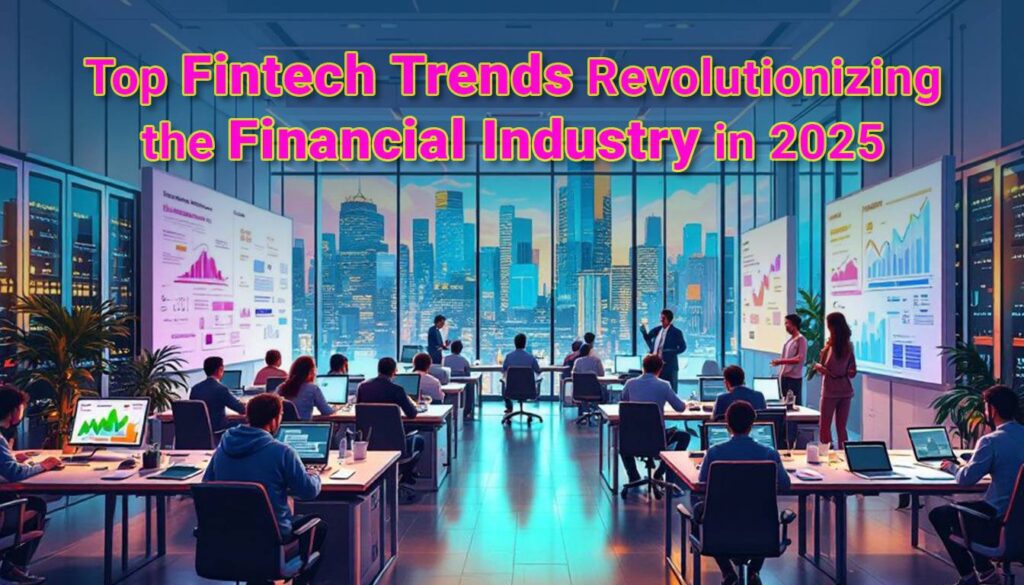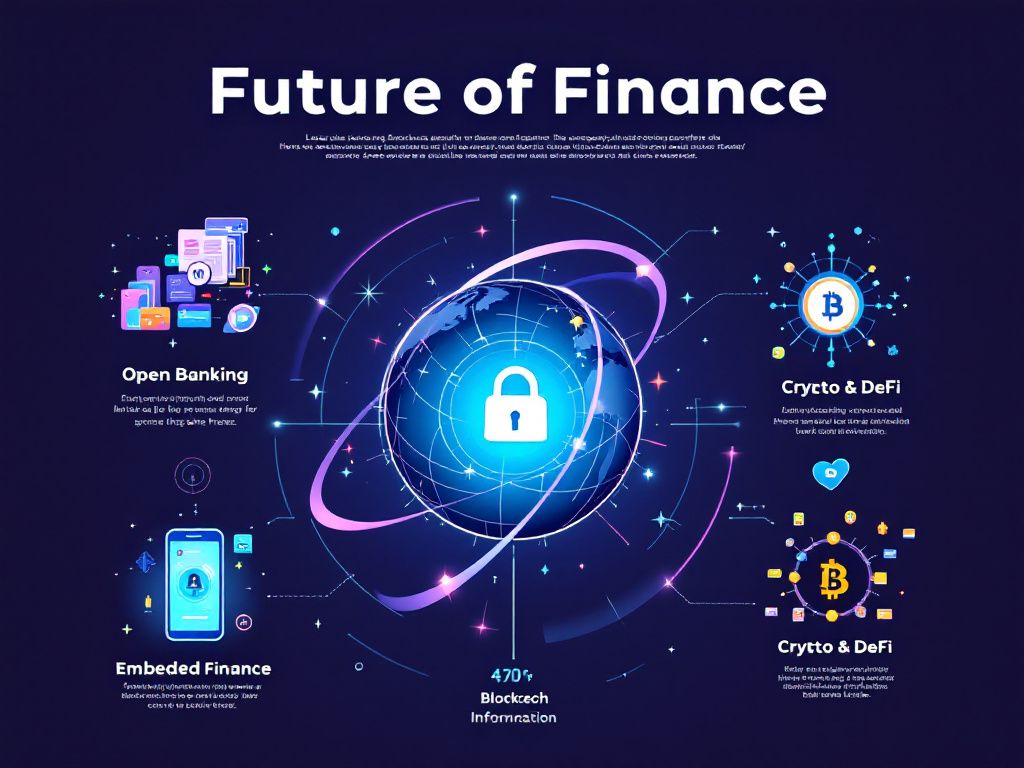The fintech industry is evolving rapidly, transforming the way we interact with money. From seamless digital payments to AI-driven financial insights, fintech is making transactions faster, more secure, and more user-friendly. But what are the top fintech trends driving this transformation? This article explores the most innovative trends shaping the global fintech landscape, including embedded finance, open banking, blockchain, AI-driven solutions, and decentralized finance (DeFi).
Let’s dive into the most significant Top fintech trends of 2025 and beyond.

What is Fintech?
Fintech, short for financial technology, refers to the integration of technology into financial services to improve efficiency, security, and accessibility. It covers a broad spectrum, from mobile banking apps to AI-powered trading platforms.
Why is Fintech Important?
- Provides faster and more efficient financial services
- Enhances security through encryption and biometric authentication
- Expands financial inclusion, allowing more people to access banking services
The fintech industry has witnessed exponential growth, with startups and tech giants investing heavily in innovations. But what are the key trends driving this growth? Let’s find out.
Top Fintech Trends in the World
The global fintech market is expected to surpass $300 billion by 2025, with several key trends driving this expansion. These trends are shaping the financial landscape, improving customer experiences, and making transactions faster, safer, and more efficient.
Some of the most impactful trends include:
- Embedded finance – Integrating financial services into non-financial apps
- Neobanking – The rise of digital-only banks
- Blockchain and DeFi – Revolutionizing financial transactions
- AI and Machine Learning – Automating financial services
Now, let’s take a closer look at these trends.
Embedded Finance
Embedded finance refers to integrating financial services into non-financial platforms. For example, when you buy now, pay later (BNPL) while shopping online, you’re using embedded finance.
Why is Embedded Finance Important?
- Seamless transactions – No need for third-party apps
- Better customer experience – Faster and more intuitive services
- Increased adoption – Businesses can offer financial services directly
Major companies like Uber, Amazon, and Apple have integrated embedded finance, making financial transactions effortless.
The future of embedded finance? Expect more businesses to embed lending, insurance, and payments directly into their apps.
Open Banking
Open banking allows third-party financial service providers to access consumer banking data securely, with user consent.
How Does Open Banking Benefit Users?
- Personalized financial products based on spending habits
- Better loan and mortgage offers through data analysis
- Seamless payment integrations with fintech apps
In countries like the UK and EU, open banking regulations have encouraged innovation. However, security concerns and regulatory challenges remain.
Neobanking
Neobanks are digital-only banks that operate without physical branches. Examples include Revolut, N26, and Chime.
Why Are Neobanks Growing?
- Lower fees and higher interest rates than traditional banks
- Faster transactions and digital onboarding
- Enhanced user experience with AI-driven insights
As consumers seek more flexibility and convenience, neobanks are expected to dominate the future of banking.
RegTech (Regulatory Technology)
RegTech helps businesses comply with financial regulations using AI and automation.
How Does RegTech Help?
- Automates compliance to avoid hefty fines
- Detects fraudulent transactions in real-time
- Reduces manual workload for financial institutions
As regulations become more stringent, RegTech solutions will be indispensable for banks and fintech companies.
Green Banking
Sustainability is a major focus in fintech trends 2025. Green banking refers to environmentally friendly financial practices, such as:
- Carbon footprint tracking in banking apps
- Green loans for eco-friendly projects
- Sustainable investing in ESG-compliant funds
Banks like Aspiration and Triodos are leading the way in green banking initiatives.
Artificial Intelligence and Machine Learning in Fintech
Artificial Intelligence (AI) and Machine Learning (ML) are revolutionizing the financial technology sector by automating processes, enhancing security, and improving customer experience. These technologies are used in various fintech applications, such as fraud detection, credit risk assessment, and personalized financial services.
How AI and ML Are Transforming Fintech
- Fraud Detection & Risk Management
- AI algorithms analyze transaction patterns and detect unusual activities.
- Machine learning helps in predicting fraudulent transactions before they happen.
- Personalized Financial Advice
- AI-powered chatbots and virtual assistants provide real-time financial advice.
- Banking apps use AI to offer personalized investment and savings suggestions.
- Automated Trading & Robo-Advisors
- AI-driven trading systems analyze market trends and execute trades instantly.
- Robo-advisors use ML to offer investment strategies based on risk profiles.
AI and ML are expected to continue shaping global fintech trends, making financial services smarter and more efficient.
Robo-Advisors: The Future of Wealth Management
Robo-advisors are AI-powered digital platforms that provide automated financial planning services. They analyze user data to suggest investment strategies, making wealth management accessible to everyone.
How Do Robo-Advisors Work?
- Users answer a questionnaire about their financial goals and risk tolerance.
- The robo-advisor creates a diversified investment portfolio.
- AI continuously adjusts the portfolio based on market conditions.
Advantages of Robo-Advisors
✅ Low Fees: Unlike traditional financial advisors, robo-advisors charge minimal fees.
✅ 24/7 Monitoring: AI keeps track of investments and optimizes them automatically.
✅ No Human Bias: Investment decisions are purely data-driven.
With their growing popularity, robo-advisors are redefining the investment industry.
Decentralized Finance (DeFi): The Future of Financial Independence
Decentralized Finance (DeFi) is one of the top fintech trends disrupting the traditional financial system. It eliminates intermediaries like banks, allowing users to conduct financial transactions on a peer-to-peer blockchain network.
Why is DeFi Important?
- Permissionless Transactions – No banks or regulatory approval required.
- Smart Contracts – Automates agreements without intermediaries.
- Global Accessibility – Anyone with internet access can participate.

Popular DeFi applications include lending protocols (Aave, Compound), decentralized exchanges (Uniswap, PancakeSwap), and yield farming.
As fintech trends in 2025 continue evolving, DeFi is set to revolutionize financial services globally.
Blockchain in Fintech: The Foundation of Transparency
Blockchain technology plays a crucial role in modern fintech, providing security, transparency, and efficiency.
How Blockchain is Used in Fintech?
- Secure Transactions – Reduces fraud with encrypted digital ledgers.
- Smart Contracts – Automates financial agreements.
- Cross-Border Payments – Reduces transaction time and fees.
Companies like Ripple and Stellar are using blockchain to improve financial infrastructure.
Blockchain will continue to shape global fintech trends by offering a more secure and decentralized financial ecosystem.
Cryptocurrency and Its Impact on Fintech
Cryptocurrencies like Bitcoin, Ethereum, and Solana have changed the way people perceive digital assets and finance. With crypto adoption increasing, financial institutions are integrating blockchain-based solutions.
How Crypto is Transforming Fintech?
- Cross-Border Transactions – Faster and cheaper international payments.
- Decentralization – No need for banks to process transactions.
- Smart Contracts – Enables automated agreements on blockchain.
Major companies like Tesla and PayPal now accept cryptocurrencies as payment, further proving their mainstream adoption.
Smart Contracts: Automating Transactions Securely
Smart contracts are self-executing contracts with terms directly written into code. They eliminate the need for third parties, ensuring fast, transparent, and secure transactions.
Where Are Smart Contracts Used?
- DeFi lending platforms automate loan agreements.
- Real estate transactions can be processed securely.
- Insurance claims can be automatically verified and paid.
With the increasing adoption of blockchain, smart contracts will become a standard in fintech transactions.
Stablecoins: The Future of Digital Currencies?
Unlike volatile cryptocurrencies, stablecoins are pegged to assets like USD, gold, or other currencies, providing price stability.
Popular Stablecoins
- USDT (Tether) – Backed by USD reserves.
- USDC (USD Coin) – Used widely for crypto payments.
- DAI – Decentralized stablecoin pegged to USD.
Stablecoins are playing a significant role in global fintech trends, allowing businesses to adopt crypto without high volatility risks.
BNPL (Buy Now, Pay Later): The Rise of Flexible Payments
BNPL (Buy Now, Pay Later) services are changing consumer shopping habits. Platforms like Affirm, Klarna, and Afterpay allow users to purchase products and pay in installments.
Why is BNPL Gaining Popularity?
- No interest fees (in most cases).
- Easy approval compared to credit cards.
- Encourages responsible spending.
While BNPL fintech trends 2025 look promising, there are concerns about over-indebtedness among users.
Payment Gateways: The Backbone of Digital Transactions
Payment gateways facilitate secure and seamless transactions between buyers and sellers.
Popular Payment Gateways
- PayPal – Global leader in online payments.
- Stripe – Advanced API for businesses.
- Square – Great for small businesses.
Innovations like AI fraud detection and blockchain-based transactions are making payment gateways more secure.
Biometric Authentication in Fintech
Security is a major concern in fintech, and biometric authentication offers a solution by using unique physical characteristics.
Types of Biometric Authentication
- Fingerprint scanning – Used in mobile banking apps.
- Facial recognition – Ensures secure logins.
- Voice recognition – Used for voice payments.
Fintech companies are rapidly adopting biometric authentication to enhance security.
Customer-Focused Fintech Solutions
Customer experience is at the heart of fintech innovation. AI-driven chatbots, intuitive mobile apps, and personalized financial insights are making banking more customer-friendly.
How Fintech is Improving User Experience?
- Instant customer support with AI chatbots.
- Personalized spending insights using machine learning.
- Seamless digital onboarding without paperwork.
With a focus on user convenience, fintech is making finance more accessible than ever.
Voice Payments: The Next Big Thing in Fintech
Voice technology is making its way into fintech. Voice payments allow users to make transactions using voice commands, powered by AI assistants like Siri, Alexa, and Google Assistant.
Advantages of Voice Payments
- Faster transactions without typing.
- Hands-free convenience for users.
- Enhanced security with voice authentication.
As AI continues to advance, voice payments will become more widespread.

Gamification in Fintech
Gamification is being used to engage users and improve financial literacy. Apps use rewards, leaderboards, and interactive challenges to encourage savings and investments.
Examples include:
- Chime – Offers cashback rewards.
- Monzo – Uses gamified budgeting tools.
Gamification is making fintech more fun and engaging, especially for younger generations.
Fintech Solution with TechMagic
TechMagic is at the forefront of fintech innovation, offering advanced solutions for:
- AI-powered financial analytics
- Secure blockchain transactions
- Custom fintech app development
With cutting-edge technology, TechMagic is driving the future of fintech.
Conclusion
The top fintech trends are reshaping the financial industry, making transactions faster, safer, and more convenient than ever before. Innovations like embedded finance, open banking, blockchain, and AI-driven automation are enhancing financial services worldwide. These trends are not just about technology; they are about improving customer experiences, increasing accessibility, and redefining the way we handle money.
As we look toward fintech trends in 2025, it’s clear that the future belongs to decentralized finance (DeFi), biometric security, voice payments, and AI-powered robo-advisors. Businesses and consumers must embrace these innovations to stay ahead in the digital economy.
Whether it’s neo banking replacing traditional banking, BNPL offering flexible payments, or RegTech ensuring compliance, fintech is pushing the boundaries of financial services. The next decade will see even more disruption, as fintech companies continue to innovate and redefine financial accessibility for everyone.
The question is: Are you ready to embrace the future of fintech?
FAQs
1. What are the top fintech trends shaping the financial industry?
The biggest fintech trends include embedded finance, open banking, AI and machine learning, blockchain, decentralized finance (DeFi), robo-advisors, and biometric authentication. These trends are revolutionizing banking, payments, and investment management, offering smarter and more personalized financial solutions.
2. How is AI transforming the fintech industry?
AI is enhancing fraud detection, improving customer support with chatbots, personalizing investment advice, and automating risk assessment. Machine learning algorithms analyze transaction patterns to detect fraud, while AI-powered robo-advisors provide real-time financial insights and investment strategies.
3. What is the role of blockchain in fintech?
Blockchain technology is being used in fintech for secure transactions, decentralized finance (DeFi), smart contracts, and cross-border payments. It eliminates intermediaries, enhances transparency, and ensures faster and safer transactions in various financial sectors.
4. How does Buy Now, Pay Later (BNPL) work, and is it safe?
BNPL services allow consumers to purchase items and pay in interest-free installments. While it provides flexibility, it can lead to over-indebtedness if not managed properly. Consumers should ensure they can afford repayments to avoid late fees or potential credit score impacts.
5. What is the future of fintech in 2025 and beyond?
By 2025, fintech will focus on AI-powered automation, increased use of voice payments, wider adoption of blockchain-based financial solutions, and greater reliance on biometric authentication for security. The rise of green banking and ESG-focused fintech solutions will also drive sustainable financial practices.